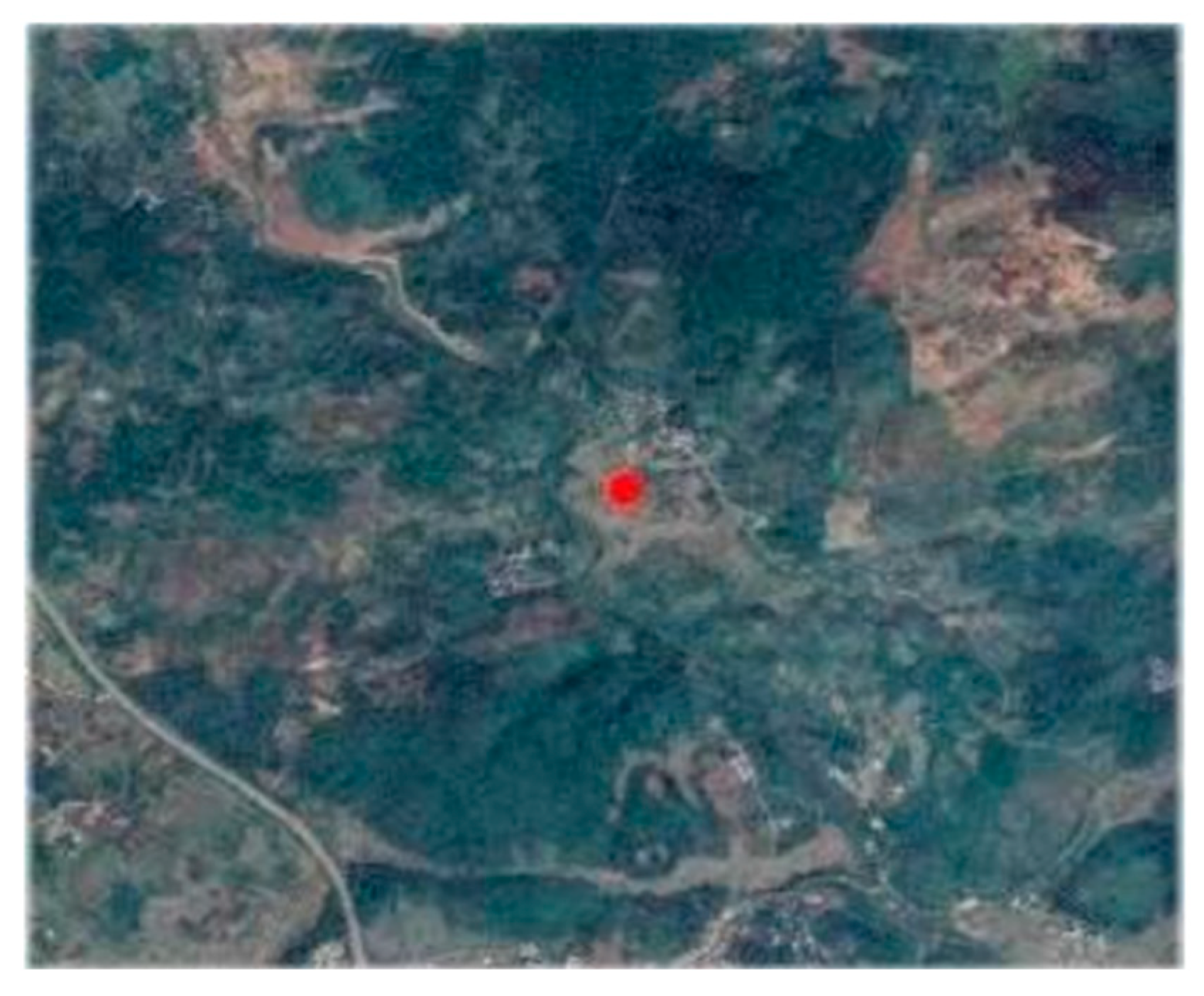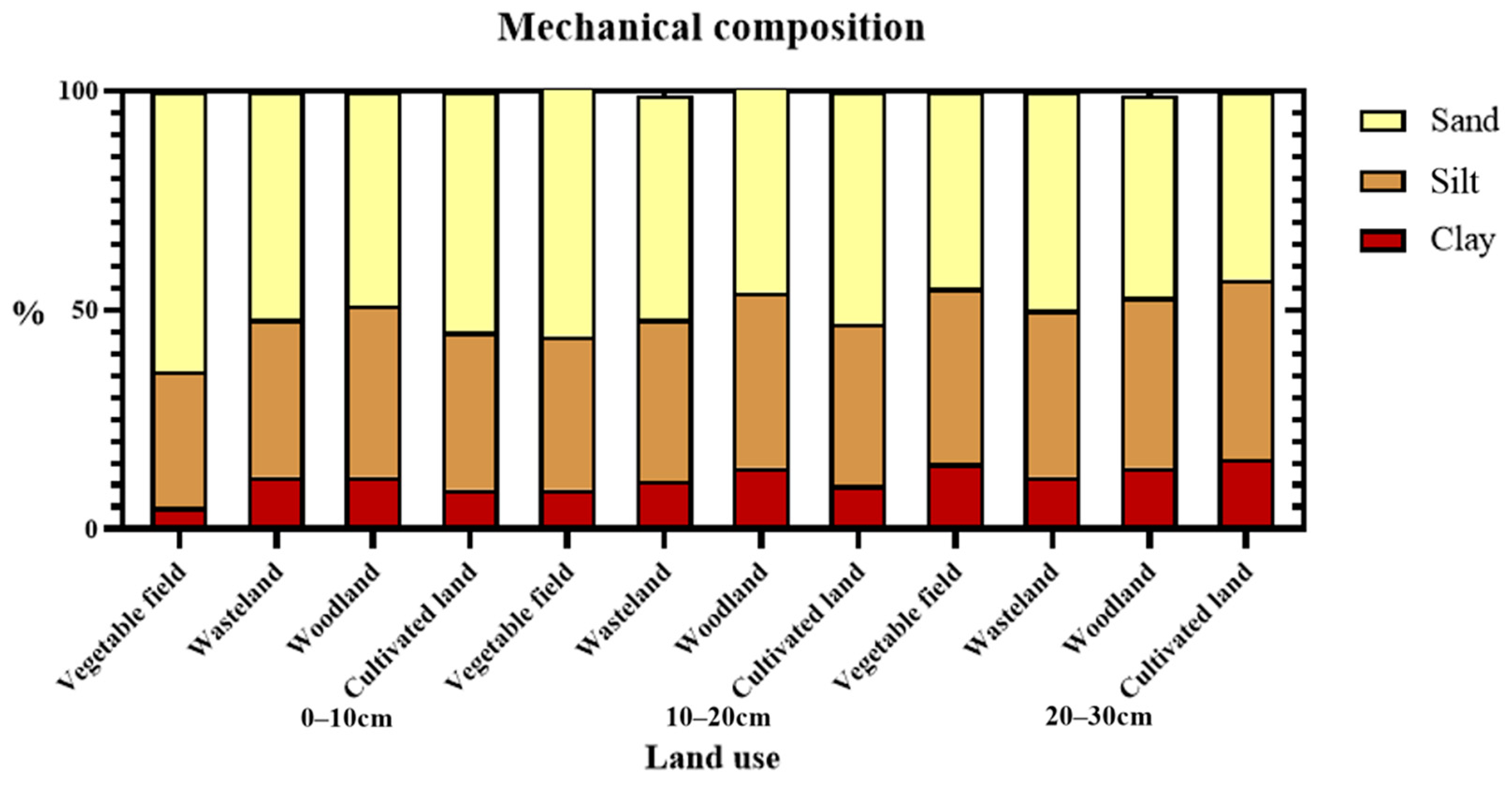Land Use Changes Influence the Soil Enzymatic Activity and Nutrient Status in the Polluted Taojia River Basin in Sub-Tropical China
Abstract
:1. Introduction
2. Study Area and Methods
2.1. Location of the Study Area
2.2. Sampling
2.3. Determination of the Soil Parameters
2.4. Data Processing
3. Results
3.1. Effects of Different Land Use Practices on the Physical Properties of Soil
3.2. Effect of Various Land Use Types on the Chemical Properties of Soil
3.3. Changes in Soil Enzyme Activity under Different Land Use Types
3.4. Correlation Analysis of Soil Enzyme Activity, Soil pH, and Soil Nutrients
3.5. Correlation Analysis of Physical and Chemical Properties of Soil under Different Land Use Types
4. Discussion
5. Conclusions
Author Contributions
Funding
Institutional Review Board Statement
Informed Consent Statement
Data Availability Statement
Acknowledgments
Conflicts of Interest
References
- Luo, K.; Li, B.; Moiwo, J.P. Monitoring Land-Use/Land-Cover Changes at a Provincial Large Scale Using an Object-Oriented Technique and Medium-Resolution Remote-Sensing Images. Remote Sens. 2018, 10, 2012. [Google Scholar] [CrossRef] [Green Version]
- Lu, H.; Cao, L.; Liang, Y.; Yuan, J.; Zhu, Y.; Wang, Y.; Gu, Y.; Zhao, Q. Mineral-leaching chemical transport with runoff and sediment from severely eroded rare-earth tailings in southern China. Solid Earth 2017, 8, 845–855. [Google Scholar] [CrossRef] [Green Version]
- Wang, Z.H.; Lina, L. Sepiolite-Based Adsorbents for the Removal of Potentially Toxic Elements from Water: A Strategic Review for the Case of Environmental Contamination in Hunan, China. Int. J. Environ. Res. Public Health 2018, 15, 1653. [Google Scholar] [CrossRef] [PubMed]
- Ma, L.; Sun, J.; Yang, Z.; Wang, L. Heavy metal contamination of agricultural soils affected by mining activities around the Ganxi River in Chenzhou, Southern China. Environ. Monit. Assess. 2015, 187, 731. [Google Scholar] [CrossRef]
- He, L.; Su, R.; Chen, Y.; Zeng, P.; Du, L.; Cai, B.; Zhang, A.; Zhu, H. Integration of manganese accumulation, subcellular distribution, chemical forms, and physiological responses to understand manganese tolerance in Macleaya cordata. Environ. Sci. Pollut. Res. 2022, 29, 39017–39026. [Google Scholar] [CrossRef]
- Jiang, F.; Ren, B.; Hursthouse, A.S.; Zhou, Y. Trace Metal Pollution in Topsoil Surrounding the Xiangtan Manganese Mine Area (South-Central China): Source Identification, Spatial Distribution and Assessment of Potential Ecological Risks. Int. J. Environ. Res. Public Health 2018, 15, 2412. [Google Scholar] [CrossRef] [Green Version]
- An, H.; Wu, X.; Zhang, Y.; Tang, Z. Effects of land-use change on soil inorganic carbon: A meta-analysis. Geoderma 2019, 353, 273–282. [Google Scholar] [CrossRef]
- Su, R.; Ou, Q.; Wang, H.; Luo, Y.; Dai, X.; Wang, Y.; Chen, Y.; Shi, L. Comparison of Phytoremediation Potential of Nerium indicum with Inorganic Modifier Calcium Carbonate and Organic Modifier Mushroom Residue to Lead–Zinc Tailings. Int. J. Environ. Res. Public Health 2022, 19, 10353. [Google Scholar] [CrossRef]
- Han, L.; Chen, Y.; Chen, M.; Wu, Y.; Su, R.; Du, L.; Liu, Z. Mushroom residue modification enhances phytoremediation potential of Paulownia fortunei to lead-zinc slag. Chemosphere 2020, 253, 126774. [Google Scholar] [CrossRef]
- Varjani, S.; Upasani, V.N. Influence of abiotic factors, natural attenuation, bioaugmentation and nutrient supplementation on bioremediation of petroleum crude contaminated agricultural soil. J. Environ. Manag. 2019, 245, 358–366. [Google Scholar] [CrossRef]
- Wu, W.; Lin, H.; Fu, W.; Penttinen, P.; Li, Y.; Jin, J.; Zhao, K.; Wu, J. Soil Organic Carbon Content and Microbial Functional Diversity Were Lower in Monospecific Chinese Hickory Stands than in Natural Chinese Hickory–Broad-Leaved Mixed Forests. Forests 2019, 10, 357. [Google Scholar] [CrossRef] [Green Version]
- Sarfraz, R.; Li, S.; Yang, W.; Zhou, B.; Xing, S. Assessment of Physicochemical and Nutritional Characteristics of Waste Mushroom Substrate Biochar under Various Pyrolysis Temperatures and Times. Sustainability 2019, 11, 277. [Google Scholar] [CrossRef] [Green Version]
- De Oliveira Silva, É.; de Medeiros, E.V. Seasonal effect of land use type on soil absolute and specific enzyme activities in a Brazilian semi-arid region. Catena 2019, 172, 397–407. [Google Scholar] [CrossRef]
- Lasota, J.; Błońska, E.; Lasota, J.; Błońska, E.; Babiak, T.; Piaszczyk, W.; Stępniewska, H.; Jankowiak, R.; Boroń, P.; Lenart-Boroń, A. Effect of Charcoal on the Properties, Enzyme Activities and Microbial Diversity of Temperate Pine Forest Soils. Forests 2021, 12, 1488. [Google Scholar] [CrossRef]
- Van Leeuwen, J.; Djukic, I.; Bloem, J.; Lehtinen, T.; Hemerik, L.; de Ruiter, P.; Lair, G. Effects of land use on soil microbial biomass, activity and community structure at different soil depths in the Danube floodplain. Eur. J. Soil Biol. 2017, 79, 14–20. [Google Scholar] [CrossRef]
- Qin, M.; Zhang, Q.; Pan, J.; Jiang, S.; Liu, Y.; Bahadur, A.; Peng, Z.; Yang, Y.; Feng, H. Effect of arbuscular mycorrhizal fungi on soil enzyme activity is coupled with increased plant biomass. Eur. J. Soil Sci. 2020, 71, 84–92. [Google Scholar] [CrossRef]
- Dang, X.; Liu, G.; Xue, S.; Li, P. An ecological footprint and emergy based assessment of an ecological restoration program in the Loess Hilly Region of China. Ecol. Eng. 2013, 61, 258–267. [Google Scholar] [CrossRef]
- Xiao, S.; He, J.; Zeng, C.; Wang, J. Soil Chemical Properties under Various Land-Use Types in the Karst Area with a Case Study in Shibing County of China. J. Chem. 2021, 2021, 5523060. [Google Scholar] [CrossRef]
- Yan, T.; Zhao, W.; Zhu, Q.; Xu, F.; Gao, Z. Spatial distribution characteristics of the soil thickness on different land use types in the Yimeng Mountain Area, China. Alex. Eng. J. 2021, 60, 511–520. [Google Scholar] [CrossRef]
- Kebebew, S.; Bedadi, B.; Erkossa, T.; Yimer, F.; Wogi, L. Effect of Different Land-Use Types on Soil Properties in Cheha District, South-Central Ethiopia. Sustainability 2022, 14, 1323. [Google Scholar] [CrossRef]
- Lucas-Borja, M.E.; Zema, D.A. Effects of different land uses (abandoned farmland, intensive agriculture and forest) on soil hydrological properties in Southern Spain. Water 2019, 11, 503. [Google Scholar] [CrossRef] [Green Version]
- Cao, H.; Wang, Z. Research on the Regional Environmental Impact and Risk Assessment Affected by Mineral Resource Development: A Case Study of the Taojia River Watershed in Hunan. Front. Ecol. Evol. 2022, 10, 918446. [Google Scholar] [CrossRef]
- Xu, J.; Dai, H.M.; Liu, G.D.; Song, Y.H. Changes of soil enzyme activity under different land use methods. Geol. Resour. 2020, 29, 579–584. [Google Scholar]
- Seidel, F.; Lopez, C. N Isotope Fractionation in Tree Tissues during N Reabsorption and Remobilization in Fagus crenata Blume. Forests 2019, 10, 330. [Google Scholar] [CrossRef] [Green Version]
- Kuang, S.L.; Tan, B.W. Analysis and study on climate characteristics in recent 60a, Chenzhou, Hunan Province. Beijing Agric. 2016, 2, 141–142. [Google Scholar]
- Li, X.; Zhao, Z. Heavy metal accumulation and its spatial distribution in agricultural soils: Evidence from Hunan province, China. RSC Adv. 2018, 8, 10665–10672. [Google Scholar] [CrossRef] [Green Version]
- Chen, L.C.; Guan, X. Spatiotemporal patterns of carbon storage in forest ecosystems in Hunan Province, China. For. Ecol. Manag. 2019, 432, 656–666. [Google Scholar] [CrossRef]
- Mendes, M.S.; Latawiec, A.E.; Sansevero, J.; Crouzeilles, R.; Moraes, L.F.D.; Castro, A.; Alves-Pinto, H.N.; Brancalion, P.H.S.; Rodrigues, R.R.; Chazdon, R.L.; et al. Look downthere is a gapthe need to include soil data in Atlantic Forest restoration. Restor. Ecol. 2019, 2, 361–370. [Google Scholar] [CrossRef]
- Song, Q.; Gao, X. Cultivation impacts on soil texture during oasis expansion in Xinjiang, Northwest China: Wind erosion effects. Aeolian Res. 2021, 50, 100646. [Google Scholar] [CrossRef]
- Weaver, B.; Wuensch, K.L. SPSS and SAS programs for comparing Pearson correlations and OLS regression coefficients. Behav. Res. Methods 2013, 45, 880–895. [Google Scholar] [CrossRef]
- Yang, T.; Jing, H. Soil particle composition and its fractal dimension characteristics of different land uses in Loess hilly region. Res. Soil Water Conserv. 2016, 23, 1. [Google Scholar]
- Yu, X.; Zhou, W.; Chen, Y.; Wang, Y.; Cheng, P.; Hou, Y.; Wang, Y.; Xiong, X.; Yang, L. Spatial variation of soil properties and carbon under different land use types on the Chinese Loess Plateau. Sci. Total Environ. 2020, 703, 134946. [Google Scholar] [CrossRef] [PubMed]
- Lei, H.; Wang, L. Impact of environmental acidity on the geomechanical and mineralogical behavior of marine clay. Bull. Eng. Geol. Environ. 2021, 81, 35. [Google Scholar] [CrossRef]
- Baldrian, P. Microbial activity and the dynamics of ecosystem processes in forest soils. Curr. Opin. Microbiol. 2017, 37, 128–134. [Google Scholar] [CrossRef]
- Yang, S.Y.; Zhang, L.L.; Xu, Y.L.; Wang, S.; Li, Z.J. Effects of different land use methods on soil organic matter in K K river basin. Anhui Agric. Sci. Bull. 2021, 27, 118–121. [Google Scholar]
- Carranca, C.; Castro, I.V. Influence of tree canopy on N-2 fixation by pasture legumes and soil rhizobial abundance in Mediterranean oak woodlands. Sci. Total Environ. 2015, 506, 86–94. [Google Scholar] [CrossRef]






Publisher’s Note: MDPI stays neutral with regard to jurisdictional claims in published maps and institutional affiliations. |
© 2022 by the authors. Licensee MDPI, Basel, Switzerland. This article is an open access article distributed under the terms and conditions of the Creative Commons Attribution (CC BY) license (https://creativecommons.org/licenses/by/4.0/).
Share and Cite
Yuan, C.; Liang, S.; Wu, X.; Farooq, T.H.; Liu, T.; Hu, Y.; Wang, G.; Wang, J.; Yan, W. Land Use Changes Influence the Soil Enzymatic Activity and Nutrient Status in the Polluted Taojia River Basin in Sub-Tropical China. Int. J. Environ. Res. Public Health 2022, 19, 13999. https://doi.org/10.3390/ijerph192113999
Yuan C, Liang S, Wu X, Farooq TH, Liu T, Hu Y, Wang G, Wang J, Yan W. Land Use Changes Influence the Soil Enzymatic Activity and Nutrient Status in the Polluted Taojia River Basin in Sub-Tropical China. International Journal of Environmental Research and Public Health. 2022; 19(21):13999. https://doi.org/10.3390/ijerph192113999
Chicago/Turabian StyleYuan, Chenglin, Siqi Liang, Xiaohong Wu, Taimoor Hassan Farooq, Tingting Liu, Yu Hu, Guangjun Wang, Jun Wang, and Wende Yan. 2022. "Land Use Changes Influence the Soil Enzymatic Activity and Nutrient Status in the Polluted Taojia River Basin in Sub-Tropical China" International Journal of Environmental Research and Public Health 19, no. 21: 13999. https://doi.org/10.3390/ijerph192113999







